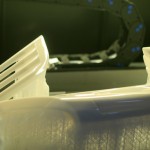
(English below)
Viele Citroën-Fans kennen vielleicht die Konzeptstudie “GT by Citroën” als einen Meilenstein im modernen Fahrzeugdesign des Pariser Unternehmens. Was die meisten allerdings nicht wissen, ist, daß mittlererweile eine 3D-Druck-Technologie seit Jahren im Konzeptbau Einzug gehalten hat, und die zeitaufwendige manuelle Fertigung von Schreinern und Modellbauern durch ein ökonomisches und vor allem schnelles Verfahren ersetzt hat. So sind beim Citroën GT wie auch schon bei der Studie Hypnos die meisten Elemente des Innenraums aus einem von der Firma Materialise entwickelten Rapid Prototyping Verfahren gebaut worden.
 Die eigens entwickelte und derzeit weltgrößte Maschine ist in der Lage, im Stereolithographie-Additive-Layer-Verfahren bis zu 2,10m x 70cm x 80cm große Stücke herzustellen.
Die eigens entwickelte und derzeit weltgrößte Maschine ist in der Lage, im Stereolithographie-Additive-Layer-Verfahren bis zu 2,10m x 70cm x 80cm große Stücke herzustellen.
Basierend auf einer 3D-CAD-Datei wird zunächst das zu erzeugende Modell in horizontale Einzelschichten zerlegt, wobei für Überhänge und Einschlüsse weitere temporäre Stützstrukturen hinzugefügt werden. In eine Wanne wird ein Flüssigpolymer eingefüllt, welches dann mit einem fokussierten und computergesteuerten Laserstrahl Schicht für Schicht zum Erhärten gebracht wird. So entsteht von unten nach oben das fertige Modell. Anschließend werden die vorübergehend notwendigen Stützstrukturen wieder entfernt.
3D Printing ist eine noch recht junge Technologie, die erst seit ca. 2003 zu einem industriellen Verfahren entwickelt wurde und der man große Chancen in einem milliardenschweren Markt voraussagt.
Wer weitere Details des faszinierenden Fertigungsverfahrens nachlesen will, dem sei die Website des Unternehmens bzw. des “GT by Citroën”-Produktionsprozesses empfohlen:
http://i.materialise.com/blog/entry/3d-printing-a-supercar,
oder beispielsweise auch ein Artikel in “The Economist”
(weiterer: “A Factory On Your Desk” bzw. auf der ACI-D Website).
Mit dieser Technologie im Hintergrund ist es nunmehr an der Raffinesse und Kreativität der Designer, herausragende Entwürfe zu erarbeiten und somit die zukünftige Entwicklung des (nicht nur) Automobilbaus zu beeinflussen.
Flaminio Bertoni hätte daran sicherlich seine helle Freude gehabt!
Am ganz anderen Ende der Größenskala hat sich der niederländische Hersteller A2Models positioniert. Auch hier werden im 3D-Print eigene Entwürfe von zumeist Citroen-Modellen realisiert, hier allerdings in einem technologisch einfacheren Inkjet-Verfahren, das mit Kompositpulvern und einem aufgesprühten Härter arbeitet. Vorteil hier ist, daß die 3D-Fertigungen gleich vielfarbig gebaut werden können.
Was lag hier näher, als eine Kleinserie von 2CV AZU in den Regenbogenfarben auf den Markt zu bringen? Die 1:76 großen Modelle der Kastenente werden im Set verkauft. Weitere Infos hierzu – und zu den vielen anderen Modellen von A2Models auf deren Website: a2models.nl
—–
3D Print – in large and smaller scale models: GT by Citroën and 2CV AZU 1:76
Many Citroën lovers certainly do recognise the concept car “GT by Citroën” being one of the milestones in recent automobile design of the famous French carmaker. What many people do not know though is that for creating parts of these unique prototypes, a 3D print technology now is an embedded part of the production process.
Due to an efficient and less time consuming method, exact three-dimensional models can be created within a very short time frame. As one of the examples, Citroën has used this technology for creation of interior works on the study “Hypnos” as well as on the “GT” by using a rapid prototyping technology from Materialise.
To quote from their website: “…For the GT by Citroën, Materialise realized most of the cabin interior parts. The shapes look highly stylized and futuristic, which perfectly matches with a virtual car design… the interior was designed to create an impression that the cabin is literally on fire… Here you can see a screenshot from Magics showing the frame of the car with the 3D printed parts highlighted in purple, blue, red and green…”
The parts for the GT by Citroën interior were created by print technology on a stereolithography machine, in this case being the world’s largest 3D printer, capable of printing designs of up to 2,10m x 70cm x 80cm in three dimensions.
Based on a 3D CAD source, the model is virtually being sliced into stacks, and hangover or cavities being temporarily supported by auxiiliary structures. In a tun, a liquid polymer is being shot by a computer-controlled laser beam which makes the polymer harden and leacve a solid structure behind. So layer by layer the 3D model is being created. Afterwards the auxiliary structures are being removed again.
Car manufacturers resp. their design departments have been using a 3D printing technology for concept cars for years. Interior parts, bumpers, dashboards and many other parts are 3D printed. The rest of the car typically is completely made by hand.
A more detailed story about the production process of the “GT by Citroën” can be found here:
http://i.materialise.com/blog/entry/3d-printing-a-supercar
as well as articles about the 3D printing process and market development at “The Economist”
(and also: “A Factory On Your Desk” resp. links at the ACI-D Website).
Now since that techology has emerged since ca. 2003, it is now up to the creativity of the designers to develop outstanding and remarkable concepts and to create the image of our brand for years to come.
I am sure that Flaminio Bertoni would have loved the technology!
Not in 1:1 scale but a rather decent 1:76 size, the Dutch miniature car manufacturer A2Models has established a business also based on 3D printing technology. ALthough a different technology is being used by applying an ink jet production process using composite powders and an applied / sprayed hardener.
The big benefits of such a process is that the resulting 3D models can have different color variants. SO why not realize a 2CV AZU series of models based on that? The resulting 1:76 scale cars are being sold as a set.
More info about these models and other products by A2Models at: a2models.nl
